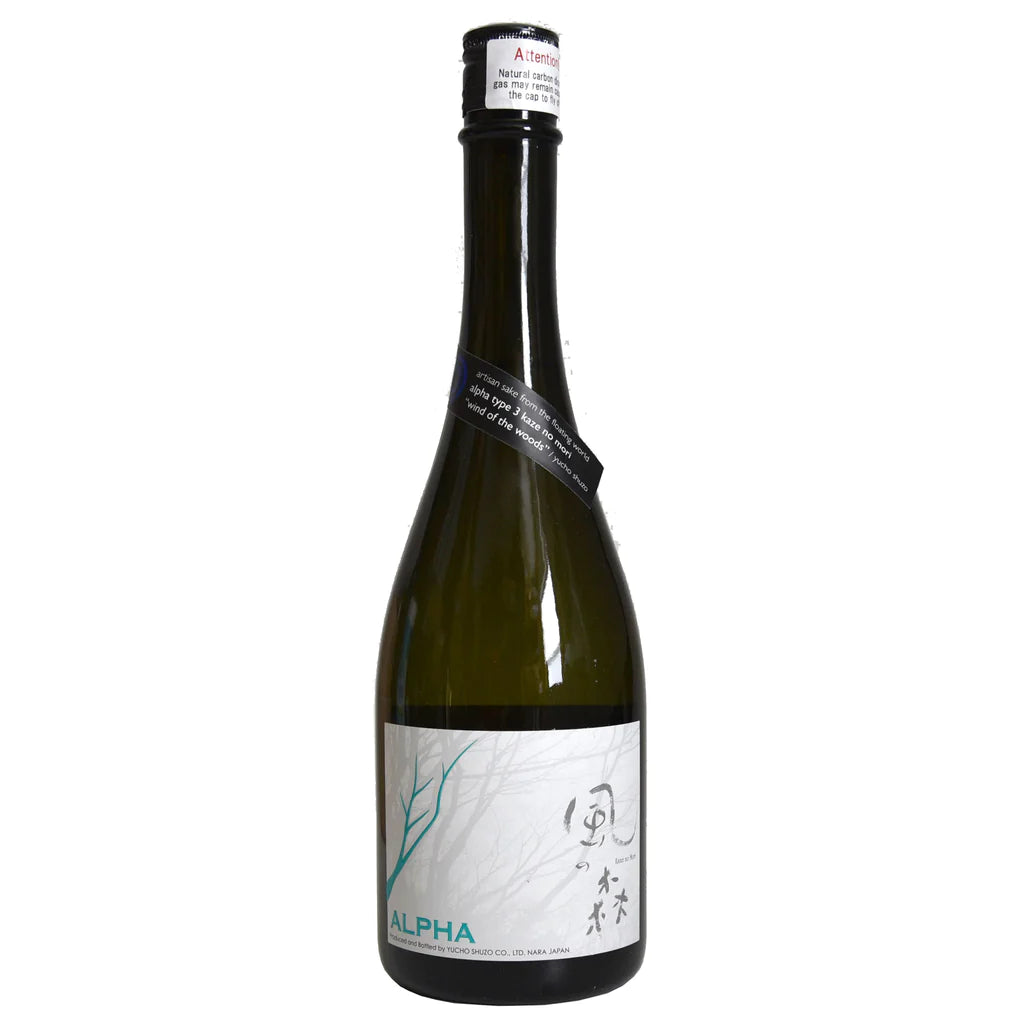
Kaze no Mori "Alpha 3" Junmai Daiginjo Muroka Genshu
- Low stock - 2 items left
Wind of the Woods' more delicate, elegant foil. If Wind of the Woods is Ramune soda, Alpha 3 is housemade elderflower soda. It's the only bottle of the Kaze no Mori series that is pasteurized and thanks to this stability, serves as the worldwide emissary for Yucho Shuzo. Alpha pushed the brewery to innovate new methods to handle pasteurized sake so that it would retain the fresh, vibrant character of nama which is emblematic of the Kaze no Mori brand.
Tasting notes
Soft lactic notes, like a homemade soda fermented naturally on the counter. Soft green melon, elderflower, orange blossom, banana leaf, & coconut water from a freshly split coconut. There is a very light carbonation here that gives the sake a sense of lift, but doesn't take it fully into sparkling territory.
Achieving "just from the press" freshness when we open a bottle here in Portland, thousands of miles away from its origin in Nara prefecture, has been a technical feat and is a multi-generational process of refinement. Yoshihiko says, "This kind of product really is alive. Open it and it's like a flower. For the consumer to enjoy it at a meal while it's in the glory of its bloom, we have to make sure that it stays in bud, so to speak, during our production phases at the brewery and during transport." There is no other sake quite like it, and this evolution-- the blossoming which takes place right in front of your eyes-- is such a huge part of what makes Kaze no Mori special, and why I recommend appreciating its evolution at home.
Chobei-san insists this regionally inspired product is not a representation of terroir. "At its root, terroir has no relationship with the production process. The term was used in the wine world to describe the special characteristics of grapes depending on where and how they're grown. With sake, you have a process whereby you use the koji to convert the starches from rice into fermentable sugars....terroir just doesn't do any justice to the path we've taken here in Nara." Out of respect for Chobei-san, I call this sake regionally representative. It inspires the spirit of Gose through its rice, its freshness and verve, and in being imbued with the wind-like essence of the Kaze no Mori pass.
Yucho Shuzo
Gose, Nara
Rice: Akitsuho (local Nara variety, technically a table rice)
Polish: 50%
Yeast: #7
ABV: 14%
Kaze no Mori means "wind of the woods" and is a regionality-driven, fresh and expressive line of sake introduced in 1998 by the 12th generation of Yucho Shuzo. Alpha is a special release series offered in batch once a year, numbering 1 to 9, and corresponding to different production methods or experiments.
Yucho Shuzo has been making sake and shochu since 1719 but faced a huge drop in demand during the 80s, forcing the brewery to reconsider its approach. At a small retail event in the 1990s the 12th president tested a theory, and poured fresh-from-the-tap, unpasteurized, undiluted Takacho for guests. He knew that this ephemeral, fresh-pressed sake was one of the most delicious experiences you can have in a brewery, and at the event it was received with great enthusiasm, providing the impetus for his new Kaze no Mori brand. The improvements in refrigerated shipping that had taken place during the same era opened the door logistically to an otherwise unstable product.
Kaze no Mori is a divergence from traditional sake: younger, wilder, with signature flavors of melon and mint, intending to deliver the "straight from the press" experience to sake drinkers. The name "Kaze no Mori" refers to the wind that soars through the city of Gose in Nara Prefecture, home to the Kaze no Mori shrine which sits at the top of a local mountain pass. It also suggests freshness and movement, which are integral to the brand's concept. The rice that grows at the top of this mountain pass is called Akitsuho, and it is the heart of both Gose and the Kaze no Mori brand.
Since 1998 the team has adapted daiginjo brewing techniques to the Kaze no Mori line, lending daiginjo-level aromatics while moderately polished rice (polished to 50-80%) lends astringent complexity, depth, and richness. The brewery utilizes a gravity flow system rather than pumps so that natural carbonation, flavor, and aroma are retained in the sake. The sake is filtered with a proprietary technology, a submerged press in the vat, in order to limit the liquid's movement. In addition, their custom bottling line (one of 2 in Japan) adjusts the level of the spout to the height of the liquid as it fills the bottle.

